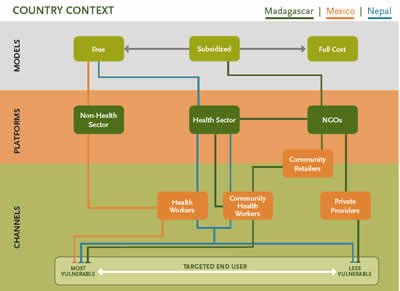Introduction
Micronutrient powders (MNP) are single-dose sachets of vitamins and minerals that are mixed into food immediately before consumption. MNP are—
- efficacious in reducing both anemia and iron deficiency
- relatively easy to use and usually do not affect the taste of foods
- available in large quantities at a relatively low cost.
However, operationalizing MNP interventions remains a complex challenge.
Objectives
- Summarize global MNP experiences
- Define components of effective MNP interventions
- Prioritize an MNP implementation research agenda

Figure: Delivery strategies
Methods
USAID’s global nutrition project, SPRING, convened MNP experts in a year-long effort to share evidence and experience for MNP interventions, complementing existing resources.

Primary data collected through 47 key informant interviews drawing from experiences in 28 countries. All informants had direct experience providing technical assistance to or implementing MNP interventions.
We obtained secondary data from a systematic literature search. A total of 81 peer-reviewed articles, 19 guidance documents, and 55 program reports or conference presentations were identified as having information on implementation experiences and were reviewed.
Key Findings
Planning, Coordination, & Supply
- An assessment of the nutrition situation that includes micronutrient data is advisable, but anemia prevalence is often the only available data.
- Advocacy, planning, and coordination have been more successful when built from existing policies, programs, systems, and resources.
- MNP are considered cost-effective, but funding remains a challenge in many countries. Initial costs can be borne or shared by external partners, but government financing or innovative delivery strategies (i.e. fee-for-product approaches) may be needed for sustainability.
- MNP are predominantly sourced from international suppliers; in a few cases, local production has been feasible with substantial investment and capacity building. Product quality is critical to build and sustain program trust.
Delivery, Behavior change, and Training
- Delivery of MNP is most common through IYCF programs given their complementarity, but often the IYCF program needs to be strengthened.
- Different combinations of models, platforms, and channels have shown potential (see figure).
- Continual behavior change communication and training have been needed to increase and sustain coverage and adherence.
- Tailoring training for private and public sectors has been necessary.
Continual Program Improvement
- A clearly articulated program theory has been developed in many MNP interventions but has rarely been used to track progress and make course corrections.
- Technical capacity to monitor and evaluate activities usually relies on external institutions, which often end their support after programs' initial research phase.
- Supervisory systems and how they should be used to improve implementation is poorly documented for MNP interventions.
Discussion
There is a lack of documented implementation experiences, particularly for larger or scaled MNP interventions. High-quality process evaluations and/or learning from large-scale or national MNP programs are needed to illuminate the best practices and constraints of sustaining an effective, scaled program. Some areas of implementation research needed, as identified during the consultative process:
- Identify best practices to build funding into scale-up plans and national programs and avoid “eternal pilots”
- Determine if a mixed or subsidized model can maintain equitable accessibility while maintaining acceptable profit margins to keep the private sector engaged
- Examine how to effectively link monitoring and process evaluation to decision-making processes
Products of the MNP Consultation
- USAID Implementation Brief
- Journal Submission
- Meeting Report Supplement
